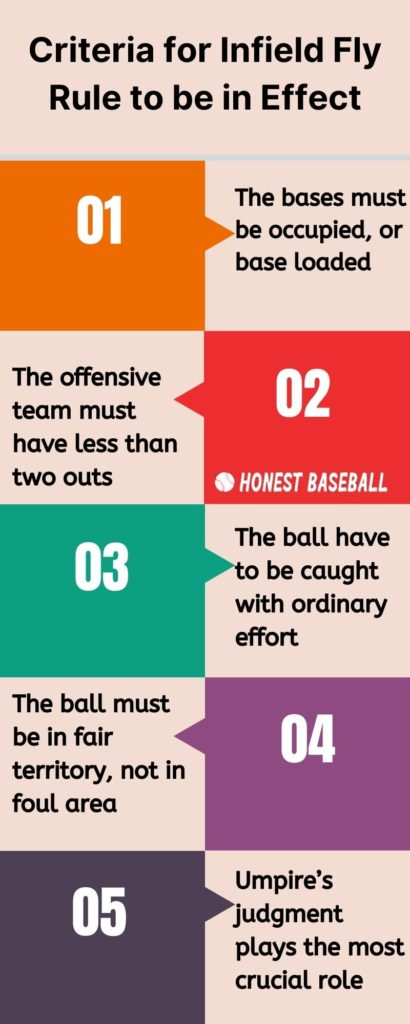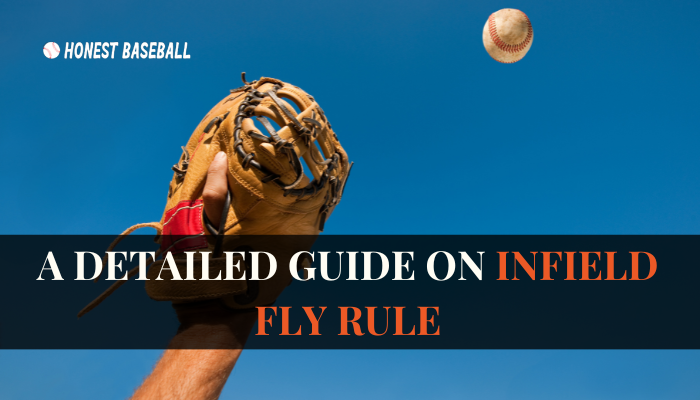If you are a baseball fan, you must know there are tons of rules here. The infield fly rule is one of them. This is one of the peculiar rules that baseball has. But what is an infield fly rule? Let’s try to understand it in short.
There are baserunners in the first and second base or the bases load. Alongside, the offensive team has one batter out. In such cases, the batter pop-up a ball in the fair territory, which the pitcher, catcher, or infielder can catch with ordinary effort. The ball might be caught or missed, but it is called an out for the batter even when it is on the fly.
Really strange. Don’t be panicked about why it is called an out, even if the ball is missed. I will try to break down the facts part by part to make you understand the infield fly rules without any firmness.
See Also: What Is ERA In Baseball? | A Wide Explanation
What Is the Infield Fly Rule?
An infield fly ball is a normal fly ball that is just popped in the area of the infield or outfield, which is accessible with an ordinary effort by the infielder. However, some primary criteria exist for the infield fly rule to be “in effect.” To understand “what is infield fly rule in baseball?” you have to understand the following.
- There are baserunners in the first and second base or the base loaded
- The offensive team has less than two batters out. In simple terms, only one out or no out.
- The batted ball isn’t a line drive or a bunt and can be caught with “ordinary effort” by the catcher, pitcher, or infielder.
- The ball must be in fair territory, not in the foul area
- Umpire’s judgment plays the most crucial role
In such a situation, the umpire will judge the fly ball hit by the batter and will call the batter out. In this case, even if the ball is missed by the fielder, it will be called an out under the infield fly rule.
On the other hand, if the ball goes to foul territory, and a fielder catches the ball, it will not be considered an infield fly rule. Let’s discuss the criteria in detail.
First, and Second Bases Occupied, Or Base Loaded
One of the criteria for an infield fly ball “in effect” is that the first and second base must be occupied by two baserunners from the offensive team. Also, if the base is loaded, it will be counted for the judgment of an infield fly rule.
Base loaded means all three bases are occupied by the baserunners from the offensive team.
The Batting Team Has Less Than Two Outs
Another big criterion of infield fly ruled to be in effect is the offensive team must have less than two outs. That means either there is no out or one out on the offensive side.
This is because the intention of the infield fly rule is to protect the offensive team from an easy double play or triple. But, there is a chance that the defensive team can play a double or triple play when a situation is created.
But, when there are already two outs in the offensive team, there will be no situation to be created to play a double by the defensive fielders. Actually, the infield fly rule is a favor for the offensive team, protecting them from easy double and triple play.

The Ball Must Be Easy-Catchable With an Ordinary Effort By an Infielder
In this section, things are a little tricky. Let’s explain it. Ordinary moves mean that the infielder must not be in trouble or run a fly ball outside the infield to catch it.
The “ordinary effort” can be impacted by the lighting of the field, weather, the position where the fielder poses, the entire surrounding situation, and so on. This is actually not something universal. Here, the umpire must show his potential to make the decision.
Umpire’s precise judgment will help him to decide whether the flying ball can be caught with an ordinary effort or not.
To understand the ordinary effort, you can refer to the definition of official baseball rules, 2021 Edition, page 150.
“ORDINARY EFFORT is the effort that a fielder of average skill at a position in that league or classification of leagues should exhibit on a play, with due consideration given to the condition of the field and weather conditions.”
The Ball Must Be in Fair Territory
This is another tricky aspect that is hard to understand. In simple terms, the ball must be in fair territory, not in foul territory. Let’s explain this.
For example, the ball lands on fair territory near the foul line. If the ball is in such a place that the fielder could catch it with ordinary effort, the ball is called an infield fly.
But things will change if the following happens.
- The ball lands on the fair territory but rolls to the foul area after landing, and
- The baserunner(s) doesn’t pass the first or third base without being touched by a fielder,
In this case, the infield fly will be canceled.
Opposingly, if the ball lands in the foul territory and rolls to the fair territory before the baserunner(s) passes first or third base and is not touched by the fielder, it will be an infield fly. As a result, the batter will be called out.
So, here, the fly ball doesn’t need to be in the infield entirely. If the infielder has the opportunity to catch the ball with an ordinary effort, even if the ball lands outside of the infield, this will also be called an infield fly.
A Crucial Criterion: Umpire’s Judgment
Hey James, wait. All are not finished. Another crucial aspect of the infield fly rule remains. This is the umpire’s judgment.
As I mentioned before, some things are tricky to understand and not universal. So, when a tricky situation is created, the infield rule relies on the umpire’s judgment. Even if all criteria of the infield fly ball are met, and the umpire doesn’t judge it as an infield fly, the ball will be considered an ordinary ball.
And it is not uncommon. Rather, with the same criteria, different umpires can make different decisions regarding an infield rule to be in effect.
What Happens When an Infield Fly Rule Is Called?
The main advantage of the infield rule is the batter is called out, and the baserunner(s) are not bound to force play, which means, the runners must not advance to the next base. So, the baserunner(s) can stay on the base where they are currently.
As we mentioned before, it is fair to the offensive team. But you can ask, “why?” There is no answer to “why,” but this is a rule the MLB has to follow.
But, Can Baserunner(s) Advance to the Next Base(s)?
Since the baserunner isn’t bound to force play, it is a willing fact that the baserunner(s) can advance to the next base(s). When the umpire calls an infield fly, the batter is out, and the ball is still a live ball.
If the ball is dropped on the ground, the baserunner(s) can advance to the next base. It is entirely up to the runner(s). But he has to do it at his own risk since if he advances, the infielder can tag him up and get out.
Watch out for the following video of what happened after an infield fly was called, and the baserunner tried to advance to the next base.
Should the Infielder Tag Up the Baserunner After Catching Up the Infield Fly Ball?
In simple terms, yes, the infielder must tag up the baserunner after catching the infield fly even though the batter is called out. It is because if the infielder doesn’t tag up the baserunner, the runner can take as many runs as he wants.
Just imagine what will happen then. The baserunner will take continuous runs, and this could be infinite!
What Is the Ultimate Purpose of the Infield Fly Rule?
The ultimate purpose of the infield fly rule is to prevent deception by the infielder. If the infield fly role doesn’t exist, the shortstop or other infielder can intentionally drop a fly ball.
As a result, the baserunners on the first and second bases must play a force play. In this case, they can be double-played by the infielder. Since the infield fly rule exists, the defensive team can do any deceiving activity to get a double or triple play.
Frequently Asked Questions
Yet do you have some questions remaining in mind about the infield fly rule? Check the following frequently asked questions that may help you to remove remaining confusion.
Q: Does the umpire have to yell infield fly?
After fulfilling all criteria, when the batted ball pops up infield, the umpire has to call the ball infield fly. He has to call “infield fly, the batter is out.”
Q: What happens if the umpire doesn’t call an infield fly?
It is certain that the judgment of the plate umpire can be wrong. So, in this case, the base umpire should give a clue to the plate umpire to understand that the batted ball could be an infield fly.
Q: Can an umpire call infield fly after the play?
The infield fly call must come when the ball is in the air. Basically, this happens after the batter hits the ball. After calling the infield, the ball gets dead. As a result, the baserunner(s) gets rid of a force play.
Wrap-Up
In summing up, the infield fly rule is something tricky and confusing to understand. But, having a clear idea about it is crucial, basically for the baseball team players and the umpires.
Most of the time, it basically depends on the umpire’s judgment. So, even if all criteria are met, a “to-be” infield fly rule might not be in effect if the umpire misjudges it.
You May Also Like:
What Does WHIP Mean In Baseball? A Comprehensive Explanation
What Does FPS Mean In Baseball?
What Are The Best Pitches To Throw In Baseball?
What are Baseball Bats Made Of?
What Is A Baseball Walk-Off | Everything About Walk-Offs

Hello everyone. My name is Jason Butler, and I live in California, America. I was a professional AAA Minor League Baseball player. I lost my chance of playing MLB for injury issues, but I did not lose my love for baseball. I attended the coaching training program and am now working as a coach in a small school in San Diego.
I always love to share my experience and knowledge if that can help you. Play baseball, and stay fit.
